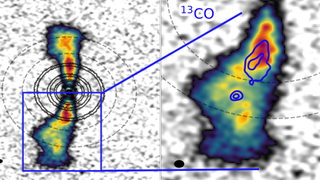Scientists spot baby alien planet that might be forming moons
"We are living in a very exciting time when this happens."

Scientists might have spotted a gassy young world.
A telescope array made the first-ever gas detection in a disk surrounding a faraway star, and that detection suggests a baby, Jupiter-mass exoplanet may have been responsible, the team behind the discovery stated.
A "blob of emitted light" near the star AS 209 shone in observations with the Atacama Large Millimeter/submillimeter Array (ALMA), in an otherwise quiet gap of gas in the star's disk, according to the National Radio Astronomy Observatory (NRAO).
Related: 10 amazing exoplanet discoveries
"The best way to study planet formation is to observe planets while they're forming. We are living in a very exciting time when this happens thanks to powerful telescopes," lead author Jaehan Bae, a professor of astronomy at the University of Florida, said in the NRAO statement Tuesday (Aug. 9).
Gassy discoveries like this one will give more information about how planetary atmospheres develop, according to the research team, along with how moons come together in the earliest stages of a solar system.
The suspected exoplanet is in a system 395 light-years from Earth, a relatively close perch in galactic terms. But the exoplanet is a whopping 200 Earth-sun distances, or astronomical units, from its host star, which stretches astronomers' understanding of how planets are formed.
Get the Space.com Newsletter
Breaking space news, the latest updates on rocket launches, skywatching events and more!
Under current planetary formation theories, scientists assume that gas giants best form in zones with a lot of gas and dust available. The outer reaches of a solar system, by contrast, are thought to be full of smaller and icier objects like our own Kuiper Belt.
There are a few possibilities scientists are considering for how the AS 209 disk may support a planet of such size, so far from its star. One idea is that the disk was gravitationally unstable in the distant past, perhaps due to a tidal disruption of some sort. Recent simulations by the team, however, suggest that such instabilities can only produce fragments of a few times the mass of Jupiter. Even if that happened, planets are less prone to migrate after accretion, according to the researchers' work.
Moreover, AS 209's disk has a relatively small mass, and appears to be stable at the moment based on its gas surface density profile and its temperature in the midplane. "While it is not impossible that the disk was sufficiently massive in the past, the small present-day disk mass implies that the disk should have lost its mass very efficiently since then," the researchers wrote in their paper, published in Astrophysical Journal Letters July 27.

Pebble accretion is the other major possibility by which the planet got so large, but the researchers are trying to figure out a few scenarios by which that might happen. It's unclear how the core of the planet grew enough and why it failed to trap millimeter grains beyond its own orbit by doing so, although researchers suggest a few ways gas accretion might make that possible.
The team also is investigating whether there were enough pebbles around to form a giant planet, which may have come together through pressure bumps or infalling flows in the gas surrounding the star. The timescale for accretion is also unclear, along with its rate.
Team members hailed the discovery as novel as the existence of circumplanetary disks around exoplanets wasn't proven up until this discovery. That said, scientists using ALMA were able to detect a moon-forming disk around the exoplanet PDS 70c in 2019 and to confirm the discovery in 2021, they noted.
Follow Elizabeth Howell on Twitter @howellspace. Follow us on Twitter @Spacedotcom and on Facebook.
Join our Space Forums to keep talking space on the latest missions, night sky and more! And if you have a news tip, correction or comment, let us know at: community@space.com.

Elizabeth Howell (she/her), Ph.D., is a staff writer in the spaceflight channel since 2022 covering diversity, education and gaming as well. She was contributing writer for Space.com for 10 years before joining full-time. Elizabeth's reporting includes multiple exclusives with the White House and Office of the Vice-President of the United States, an exclusive conversation with aspiring space tourist (and NSYNC bassist) Lance Bass, speaking several times with the International Space Station, witnessing five human spaceflight launches on two continents, flying parabolic, working inside a spacesuit, and participating in a simulated Mars mission. Her latest book, "Why Am I Taller?", is co-written with astronaut Dave Williams. Elizabeth holds a Ph.D. and M.Sc. in Space Studies from the University of North Dakota, a Bachelor of Journalism from Canada's Carleton University and a Bachelor of History from Canada's Athabasca University. Elizabeth is also a post-secondary instructor in communications and science at several institutions since 2015; her experience includes developing and teaching an astronomy course at Canada's Algonquin College (with Indigenous content as well) to more than 1,000 students since 2020. Elizabeth first got interested in space after watching the movie Apollo 13 in 1996, and still wants to be an astronaut someday. Mastodon: https://qoto.org/@howellspace
